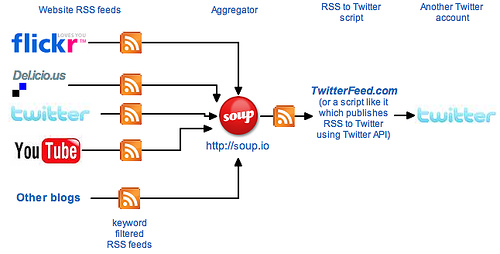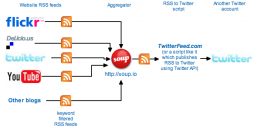In a series of posts about Twitter for organizations, guest blogger Nate Ritter gives an overview of the benefits and pitfalls using Twitter. And because he is a geek, he's got an aggregator at the ready... (Modified and posted with permission from Nate's blog.)
My experiences in the San Diego fires in Southern California in late 2007 gave me an interesting outlook on how Twitter, as a tool, could be applied in different circumstances. For those of you not in the know: Twitter is a "free social networking and micro-blogging service that allows users to send "updates" (or "tweets"; text-based posts, up to 140 characters long) to the Twitter website, via short message service, instant messaging, or a third-party application such as Twitterrific" according to the Wikipedia. Just a few months after (and some even during) the 2007 firestorm some organizations are scratching the surface of what’s possible with this service.
Twitter is a tool. It’s a good one in some cases and and for some organizations, and useless for others. Don’t make Twitter the hammer and start looking at everything like a nail. Twitter does some things very well, but it doesn’t fit every organization’s goals. Here are some considerations that will help determine if Twitter could be useful for your organization. If one of these criteria benefits your community without too many hurdles for adoption, then Twitter might be the right tool for you.
Twitter Benefits
1. Speed. You can very easily publish information more than once per minute. If distribution speed is critical, regardless of the information being distributed, Twitter may be the tool for you. [though there are limits to how many updates you can do - see below!]
2. Multi-modal with non-website (source) based alerts. Instant messaging, SMS/text messages on cell phones, RSS/Atom feeds, email alerts, badges/widgets on other sites, and other methods of distribution are available. If your community can’t be tethered to a website for it’s communications, Twitter can provide other methodologies to get that information out to them. (For SMS, four gateway numbers are currently available: short codes for the USA, Canada, and India, as well as a UK number for international use.)
3. Community publishing. There are a few (slightly more technical) ways of aggregating a group of twitterer's posts, which means you could have more people — even your community — pitching in to help publish pertinent information.
Limitations of Twitter
Yes, there are some limitations to Twitter and its usefulness.
1. Only text and links can be posted. No maps. No photos. No videos. Text and links are all you get.
2. 140 character limit. URLs will get shortened wherever possible, but 140 characters is tough to get used to.
3. No conversation threading. This can be tough to deal with when you’re used to discussion forums and such. Connecting with your community in this way is almost limited to real-time dialogue, which can limit the conversation’s depth and longevity.
4. The API has a 70 post per hour limit. Note that from what I could tell, the web UI doesn’t have this limit, but I’m sure they wouldn’t like you posting more than that unless it was an emergency anyway.
But why stop at Twitter?
Twitter was a great tool for the emergency situation we went through in southern California, but why stop there?
Here’s the thing. If you need non-website based alerts, then publishing to Twitter should be your end goal.
The limitations to Twitter are definitely not insurmountable. So lets use Twitter for what it’s good at and go find something else which can help with the things it’s missing. We’ll put together a quick example prototype using services and websites which already exist.
The end result of the next 15-30 minutes, if you follow me, will be a website which will aggregate photos, videos, blog posts, tweets (twitter posts), for whatever context you would like. We could, for instance, create a site which would show all the different types of media and content on the San Diego fires. Additionally, it would be updated automatically whenever new content is created by you or anyone else (if you want to be that open) on whatever subject you’d like.
The prototype
We’ll do this in steps. But before we do, here’s the back-of-the napkin diagram of what we’re building.

1. Grab RSS feeds from any websites you can. YouTube, Flickr, other Twitter accounts, blogs, etc. Many times, if you’re creative, you can get keyword (or “tag”) filtered RSS feeds. So, for instance, you can use the public Flickr feed for photos and add a few things to the URL which will let you filter based on tags.
2. Create a Soup.io account for your emergency, event, or organization. This part should be pretty easy.
3. Add the feeds to the Soup.io account. There’s a little tool or gear-looking icon in the bottom left of the screen. Click that and click the “Me Elsewhere” section. In the form that shows up, select “RSS feed” and paste in the feed’s URL. Do that for each service you want. Here’s an example of what it could look like.
4. If you need update alerts via something other than the website itself, you can head over to TwitterFeed.com and sign up for an account. This service allows you to take an RSS feed (like from the Soup.io account you created) and push it back into a Twitter account.
5. Grab the RSS feed for the Soup.io account you just created. Paste the URL into the TwitterFeed service you created along with whatever Twitter account and password that you want new information to post to.
Now, one thing to note here is that if you’re dealing with emergencies, you probably want to have a script produced for you which will do the the RSS to Twitter push. The reason is that TwitterFeed.com only pushes up to 5 new items every 30 minutes — certainly much less often than you’d want in a crisis. Howeever, that speed is fine for regular communications and even for advocacy communication that are more timely and urgent. It’s not too difficult for a developer to do and could most likely be contracted for about $100 or so.
Although I could, I’m not going to develop and distribute a script like that here. Doing something like this would probably irritate Soup.io a little because most service providers don’t like to be hit more than once every 30 minutes or more. In a crisis, you’d want to hit it probably once every 5 minutes or more. Plus, this is a prototype. It's just a brainstorm. If you have other ideas or tools, post a comment!
A few useful links:
A list of Twitter clones in other countries
Beth's intro: What is Twitter and What Can Nonprofits Do With It?


Post new comment